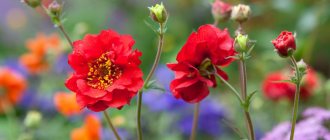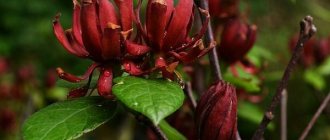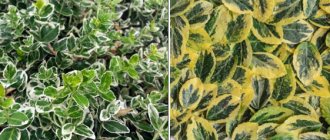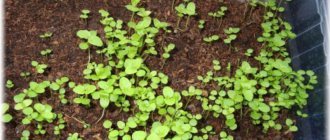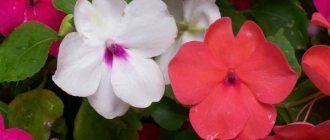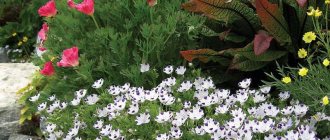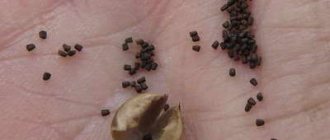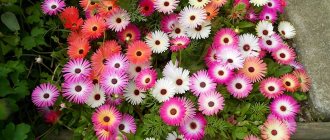Growing dahlias
Location and lighting
These flowers are light-loving, but in the summer during the hottest hours they are shaded from the sun. It is best to place the pot on an east or west window.
The room in which the plant is located must be well ventilated; in summer it can be taken out onto the balcony or into the garden, protecting it from drafts and wind.
Temperature
Dahlia is not too thermophilic. In summer, the temperature should not exceed +18°C, in winter it is lowered to +12-15°C.
Watering and air humidity
Throughout the year, abundant watering is required; in winter, the amount of water is slightly reduced, but the soil is still not allowed to dry out. For irrigation, the water is left to stand for 1-2 days.
It does not require high air humidity; it is enough to periodically spray the leaves with water at room temperature. If the air is too dry, pests may appear on the plant, and the leaves may turn yellow.
Fertilizer
Feeding is required a few days after transplantation; this is done in late spring and summer with an interval of 10 days.
The best fertilizer is a mixture of mullein infusion (1 part to 10 parts water) with the addition of superphosphate and nitrogen fertilizers (take 20 g per 10 liters of water).
Periodic fertilizing with superphosphate mixed with wood ash is also suitable (50 g of product per 10 liters).
The use of fertilizers has a beneficial effect on flowering - large and bright flowers are formed. Starting from September, fertilizing is not carried out.
Transplantation and propagation
Replanting is practically not done, since at the end of flowering the above-ground part of the plant usually dies.
Dahlia propagates by seeds that form on flowers. They are collected, slightly dried and planted in the spring in soil (a mixture of peat and sand in a ratio of 3:1), when the seedlings grow 2 true leaves, they are planted in separate pots.
The second method of propagation is using cuttings. To do this, cut off the tops of the stems and place them in a container with water or a mixture of peat and sand. For rooting, maintain a temperature of +20-25°C.
When replanting a plant with tubers, they are cut into several parts so that a piece of the root collar with eyes remains on each. Tubers are planted in the ground in May-June.
Pests and their control
Dahlias are threatened by pests such as aphids and spider mites. To get rid of them, plants are sprayed with an infusion of onion peels, garlic, dandelion or tobacco. In case of severe damage, special insecticides are used.
Pests and methods of controlling them
Yellowed and curled leaves are a signal of the appearance of aphids. If the colonies are single, then the damaged leaves are simply removed. In case of severe infestation, treatment with an insecticide is necessary.
Slugs chew through or completely destroy leaves. To combat them, metaldehyde preparations, superphosphate, and red pepper are effective - they scatter on the ground.
Plant bugs cause leaf browning. To get rid of them, dahlias are sprayed with an insecticide. It is better to carry out treatment in the morning, when the bugs are inactive.
Earwigs damage the buds by gnawing out their core. Watering once a week with a decoction of wormwood or celandine helps against earwigs.
When mold appears, treatment with a fungicide helps.
When suffering from powdery mildew, treatment with a preparation containing copper is necessary. Sulfur treatment can be applied.
Variety selection
For planting in a pot, low-growing varieties of dahlias with a small root system are used. They do not require a lot of light and large space. Their small flowers have different shapes (single-row, collared, double) and can be painted in any color. They bloom profusely and for a long time. There is no need to tie them up, shape them by pinching, pinching or shelling. The lower the height of the dahlia, the earlier it blooms.
The most popular varieties of dahlias that are suitable for planting in pots:
- Borders. These dahlias have lush bushes 50 - 70 cm high, densely dotted with flowers. Varieties from the widespread Melody border series, after planting in a pot, bloom at the end of May with richly colored, double, spherical flowers up to 12 cm in diameter.
- Dwarf borders. The height of dwarf border dahlia bushes is 30 - 40 cm. Among them, the most popular variety series is Geleri. It consists of 17 varieties. The flowers of these plants, up to 10 cm in diameter, are densely double, with slightly curled petals, and will delight you from June to October.
- Dwarf potted plants. Dwarf dahlia varieties have been selected for planting in containers. They grow up to 25 - 30 cm in height. New varieties - Tompiks, Little Tiger. Their bushes are richly decorated with single-row flowers, up to 5 cm in size. These dahlias are grown only by seeds. The dwarf variety Merry Guys has long been popular. A new collection variety series with double flowers with curled petals, up to 10 cm in diameter - Dakhlinova.
Tall varieties, for example, Severins Triumph, Barbarossa, Zoloy Kolos, are also suitable for pot planting. They are bred in large tubs. They reach a height of 1.5 m and require tying. The medium-sized varieties Ice Crystal, Yellow Jill, and Spartacus New look beautiful in pots.
Reproduction methods
Dahlias can be propagated in different ways. This allows each gardener to choose the best option.
Cuttings
To do this, use sprouts that have several internodes. The cuttings should be placed in moist soil and covered with film. When the plants take root, they are transplanted into prepared small-diameter pots filled with nutrient substrate.
By layering
Dahlias are practically not propagated this way. A more effective option would be to divide the bush. To do this, it is recommended to cut healthy tubers into pieces. Each division should have 1-2 eyes. They are then moved into boxes filled with moist substrate.
Seeds
This method is used to obtain new varieties. Annual varieties of dahlias are also grown using the seed method.
When to plant dahlias in pots
Dahlias are susceptible to cold. In temperate climate zones, the best time to plant them in pots is spring from April to early June.
When planting dahlias, the following cultural features are taken into account:
- flowering of potted dahlias begins 40 - 50 days after planting;
- if you place pots of dahlias in a warm room with a lot of light, for example, on a heated balcony in an apartment, the plant will bloom in 30 - 35 days;
- when placing pots in an open space, flowers are planted when the air temperature is above 12 degrees at night;
- When planting flowers in early March, the seedlings must be supplemented with light.
2.Dahlias - planting and care at home
2.1.Reproduction, growing from seeds
The tubers can be cut into several parts in the spring with a sharp sterile pruner. Seeds that are also sown in spring. Cover the seedlings with glass or a plastic cap to maintain the required level of humidity.
2.2.When does the dahlia bloom?
Dahlias bloom from early summer until autumn.
2.3.How to care, pruning
Dahlia shoots must be pinched to encourage branching. The first time you should pinch it is when the plant has three pairs of leaves.
2.4.Transplanting dahlias
In the spring, as they grow and develop into larger pots.
2.5.Feeding
Dahlias are fed with low-nitrogen fertilizers during the growing season. With an excess of nitrogen fertilizers, the plant will abundantly increase green mass to the detriment of flowering.
2.6.Containment temperature
Heat-loving plants, normal room temperature will do. In winter, it is advisable to lower the temperature to 12 - 15 ° C.
2.7.Lighting
The optimal location would be a very brightly lit place with light shading from direct sunlight in the summer.
2.8. Soil for growing dahlias
Plants should be grown in acidic or neutral soil, with good drainage and sufficient organic matter in the form of leaf humus and manure.
2.9.Spraying
Periodically spray the plants kept in the house.
2.10.Water potted dahlia
Water generously in the warm season, reduce watering in winter and allow the top layer of soil to dry out between waterings.
2.11.Pests and diseases of dahlias
Among the harmful insects, spider mites, bedbugs, earwigs, aphids, thrips, slugs and snails, nematodes, cutworm caterpillars, whiteflies, and bronze beetles can be dangerous.
Insects - pests
Traditional methods : mustard decoction and onion peel infusion. Mechanical control measures : manual collection of adult insects. Chemicals : insecticides Actellik, Alatar; Arrivo; Decis Profi; Spark; Hummingbird; Muraha; On the spot.
All about dahlias: planting and care
Dahlia is a beautiful flower from the Asteraceae family. It is very beautiful, it can decorate the garden for a long time and please the eye. Huge fragrant buds enchant with their luxury. They decorate borders, form a flower bed, and dahlias look elegant even alone in a pot. The color range of these flowers is wide and varied. There are more than 30 species of this flower and more than 10,000 varieties.
Interesting! In European countries, this gorgeous flower is called dalia, named after the Swedish botanist Andrea Dahl.
Rules for caring for dahlias
In order for dahlias to decorate the garden for as long as possible, the plant needs to be given attention. A few simple steps will extend the life of the flower:
- Stepsonning. Timely removal of shoots and shoots that appear on the stems allows the plant to transfer most of the nutrients and moisture to the growth and development of the central bud. The more shoots a bush grows, the slower it develops. The optimal number of stems on one bush is from 2 to 4. To obtain a luxurious bud, this procedure must be repeated throughout the entire flowering period.
- Watering. Dalia needs regular irrigation. The soil should be moist. To do this, watering is carried out once every 2-3 days. It is important not to overdo it with the amount of water. Due to increased humidity, the roots of the plant may rot. If you properly moisten the soil under dahlias, they can live from spring until autumn.
- Fertilizer application. At the same time as watering, competent gardeners apply fertilizers. This is very convenient, because all the necessary fertilizers can be dissolved in water and with this solution you can simultaneously water and fertilize the dalia. Compost, ash, superphosphate or nitrogen fertilizers are used as fertilizer. At certain stages of growth, dalia needs different fertilizers.
These rules apply to both home dahlias and dahlias growing in open ground. Everything about dahlias: planting and caring for them is simple and accessible even for a novice gardener.
Soil preparation
In order for the dahlia to bloom profusely and for a long time, the soil for planting must be:
- nutritious;
- loose;
- breathable;
- neutral or slightly acidic (at pH 4 - 5, lime is added to the soil; at pH > 8.5, peat is added).
For these plants, use a mixture labeled “For flowering”. You can prepare the substrate for planting yourself. To do this, garden soil is mixed with humus, sand, perlite, and a complex of microelements is added.
Attention! With an excess of nitrogen in the soil, potted dahlias bloom poorly, and their tubers do not tolerate wintering well. Use organic fertilizers in the soil mixture with caution.
Landing rules
Dahlia is an unpretentious flower. It can bloom even in the shade, with minimal sunlight. However, the plant may suffer from a lack of light, so to prolong the life of the flower, create comfortable conditions for it.
The site for planting dahlias is chosen to be sunny, on the south side. Dahlia loves light partial shade, so the area on the north side can be shaded by a hedge, wall or fence.
Planting dahlias in the ground
The plant needs protection from the wind, but it needs an influx of fresh air. Therefore, there should be enough free space around the plant.
Important! Planting dahlias in lowlands is prohibited.
Dahlia is not picky about soil quality. Both sandy and chernozem soil are suitable for cultivation. Naturally, plant growth is better in fertile soil.
To enrich the soil, fertilizers are added to it before planting. In spring, manure, humus or compost mass is added to the soil. Maintain neutral soil acidity. If necessary, add wood ash, slaked lime or peat.
Immediately before planting, the soil is loosened. To prevent diseases and the appearance of insects, the soil is treated with insecticidal agents.
Before planting, loosen the soil
A hole is prepared for planting dahlia. The size of the hole depends on the size of the plant tuber. The approximate depth is 25-30 cm, and the diameter is from 30 to 40 cm. The distance between the holes is 50-60 cm. Fertilizer is immersed in the hole, water is poured in, and after that the plant is placed.
The plant is placed strictly vertically, sprinkled with soil and watered. The root space is mulched with grass, sawdust or spruce branches.
Planting in open ground
Planting dahlias in open ground depends on weather conditions. The climate differs in different regions, so there is no clear time for planting. Dahlias are planted in warm soil. If planted early, dahlia roots may freeze in cold soil. When planting, it is necessary that the ambient temperature is 15-18 degrees Celsius. It is important that there are no night frosts. Dalia blooms 70-80 days after the plant is planted.
How to cut a plant
One of the popular questions remains how to cut dahlias. Starting in February, the process becomes possible. But the optimal period is still in March-April, when daylight hours increase. This method of propagation is considered one of the best for valuable flower varieties, especially if there are not many tubers. If you follow the rules, up to 50 cuttings can be taken from one root tuber. In addition, there will be a significant rejuvenation of culture.
For the sake of the cutting process, you should choose the healthiest and strongest tubers. First you need to disinfect them and leave them to dry in a bright place until the buds appear.
How to take cuttings from dahlias
Then they place the roots in a box and cover them with earth mixed with sand and humus. A tuber with an open root collar will bear more cuttings. At first, the ambient temperature will have to be maintained at +25°C. When growth appears, this value can be lowered to +18. With a small amount of natural light, you will need to use phytolamps to grow strong cuttings, at least 3 mm in diameter. After a month, 10-centimeter shoots can be taken for cuttings.
For picking, it is necessary to prepare boxes whose sides are 10 cm high. Fill them with soil with sand and peat. To protect dahlias from possible diseases, the soil is disinfected with biological preparations. Then water, cover with film and leave for 2 weeks. After this period, the cuttings can be planted.
Caring for dahlias at different times
Perennial dahlias are not picky and do not require special care. They are easy to care for. It is enough to keep the soil moist, shelter the plant from winds and drafts, hill up and loosen the soil under the flower, remove weeds, and tie up grown stems. Regular pinching is carried out - removal of side shoots.
Important! There is no need to plant annual dahlias.
In the spring, during planting, the plant needs to be fertilized with nitrogen, phosphorus and potassium fertilizers. They stimulate flower growth and bud formation.
In summer, the plant is fed to maintain green mass and treated against pests and diseases. For this purpose, mineral and organic fertilizers are used, such as ammonium nitrate and bird droppings.
Fertilizer for dahlias
To maintain proper development of the bush, pruning is carried out. From 3 to 5 shoots are left on the stem, removing the rest. The procedure is carried out weekly. Tall dahlias also produce leaves from the roots to the middle of the stem. Thus, the plant retains the strength to bloom buds.
In the fall, dahlias begin to prepare for winter. The stems of the plant are trimmed. The shortened plant should be no more than 10 cm in height. The trimmings are covered with film or foil to prevent moisture from entering, causing rot, and do not open for 3-4 days. A few days later the plant is dug up. This is done carefully, avoiding damage to the tubers. The tuber is carefully cleared of soil and washed. It is better to wash with a solution of potassium permanganate; it disinfects the tubers, preventing pathogenic diseases.
Important! Dig the tubers out of the ground before frost sets in.
Store processed tubers in a cardboard box, wooden box or other spacious container. The tubers are covered with sawdust, sand or ash to prevent drying out. The containers are put away for the winter in a cellar or other room, the temperature of which does not fall below 0 degrees and does not rise above +10. Room humidity is maintained at 50-60%.
The structure of the dalia stem is such that it is hollow inside, so the stem often breaks under the weight of the bud or from a strong gust of wind. In order for the stem to remain straight longer, a garter is made. Wooden or metal pegs are used as support. The plant is tied to a peg with elastic material, such as nylon, so as not to damage the stem.
The stem often breaks under the weight of the bud or from a strong gust of wind.
Common pests on dahlias include slugs, aphids, mites and caterpillars. An effective remedy in the fight against them is a decoction of wormwood. Pest control can also be carried out using chemical means.
To increase the number of inflorescences, dalia are pruned. Remove all side shoots and excess buds. The lower leaves are removed from the trunk. Faded buds also need to be removed.
Preparing for winter
In order for perennial plants to winter well, they need to be prepared in the fall. First you need to tidy up the area where the dahlias grow. Remove all debris, branches, weeds so that nothing remains that can serve as a reservoir for infections, bacteria, etc.
Then you need to carefully examine all the bushes for damage and diseases. All frail, lethargic and non-viable plants will need to be selected, dug up with a large lump of earth and preferably burned so that they do not infect healthy flowers. Care must also be taken during inspection.
Preparing for winter
Watering during the autumn months is of great importance for dahlias. This flower stores moisture in the three lower internodes of the stem. Therefore, if you start digging up a plant immediately after irrigation, it will most likely begin to rot. To avoid such a nuisance, it is recommended to stop watering 14 days before the expected harvest of dahlias.
When it comes to digging, experienced gardeners recommend not to rush. A hardened plant tolerates winter more easily, so the longer the flowers stay in the garden, the better. But you shouldn’t overexpose it either. The optimal time is the last days of September or the first week of October.
First, cut the stem so that a small stump remains. Then, retreating 35 cm in a circle from the root, they begin to dig out the tuber. After washing the latter, it is left to dry in a dry, well-ventilated place for 5-7 days. After this period, the roots need to be processed for better shelf life. The stems are shortened by another 3 cm. All small roots and mother tubers are removed so that they do not take away nutrients.
Among other things, many gardeners also divide the tubers in the fall. This is argued by the fact that the roots harden over the winter and it is very difficult to separate them in the spring before planting. The division must be carried out so that each piece contains a section of the root collar. This will make it easier for the dahlia to germinate.
When all these manipulations are completed, you can put the tubers aside for winter storage. They usually overwinter in basements at temperatures no higher than +6 degrees. Boxes filled with sawdust, sand or earth are excellent for these purposes. It is important not to forget to ventilate the room to avoid rotting of the tubers. If storing roots in the basement is not possible, a dark closet in the house or a balcony will do. The main thing is that the room temperature does not exceed +15 degrees.
Dahlias that have been cared for responsibly will bloom long and luxuriantly, delighting the eyes of not only the owners, but also neighbors and passers-by.
Dahlias in the Moscow region, the Urals and Siberia
In different regions of the country, dahlias grow differently.
In the southern and central parts of Russia, the flower is more susceptible to warm winds and lack of moisture. Therefore, the flowering time of a bud in Moscow and the Moscow region is much shorter. Watering has to be done more often.
In the more southern parts of Russia (Krasnodar Territory, Voronezh Region), a low-lying area is chosen for planting dahlias and surrounded by a rampart to allow water to stagnate in it.
In the Urals, spring frosts are frequent, so dalia is planted in the ground in late May - early June.
The most difficult region for growing dalia is Siberia. Choose a sunny site for growing. Planting takes place in mid-June. When planting, the lower leaves are immersed in the ground to accelerate the appearance of buds on the plant trunk. Leave no more than two trunks on the plant, otherwise it will not bloom. Already in August, the plant begins to prepare for wintering.
By following simple rules of care, the garden can be turned into a colorful greenhouse. Dahlias look spectacular in any landscape.
Optimal timing
When deciding when to plant dahlias in pots, keep in mind that they will bloom 40-50 days after planting. Therefore, it is important to determine their future fate in advance. If flowers in pots will grow indoors before flowering begins, then planting can begin in March. If planted earlier, you will have to create additional lighting for the tubers.
Many people recommend planting tubers in April-May. In this case, the dahlias can be taken outside even before flowering begins. It is important that the temperature does not fall below +12°C.
Preparatory work
Having chosen suitable varieties of dahlias for planting in pots, you should prepare the container. In low-growing species, the root system is poorly developed, so a pot with a capacity of 5-6 liters will be enough to grow them. If you plan to grow tall dahlias, you will need containers with a volume of 7-20 liters.
Most often, potted dahlias are planted in:
- clay and plastic pots;
- buckets;
- wicker containers and baskets;
- wooden boxes.
For planting dahlias, choose a container that is at least 30 cm in height and width. It is better to give preference to heavy pots so that they do not tip over under the weight of the flowers.
Sulfur: benefits and harm to the human body
Many people advise growing dahlias in clay pots, because they allow air to pass well to the roots and prevent them from overheating. But you should handle them carefully; they are extremely fragile.
If there are not enough drainage holes, they must be added. Through them, water can quickly drain without stagnating in the soil. If the holes are small or not enough, moisture will begin to accumulate and the roots may rot.
Before planting, you need to thoroughly rinse the pots in which the flowers previously grew. But it is also recommended to treat them with disinfectants without chlorine.
Disembarkation rules
When planting dahlias, keep in mind that flowers are picky about the soil. Instead of ordinary garden soil, it is better to take coarse-grained, loosened soil. It is important to provide air access to the roots of the flower. When figuring out how to plant a dahlia in a pot, you need to listen to experienced gardeners. They advise:
- add hygroscopic granules to the soil mixture, which can remove excess moisture from the soil;
- Place filters from the coffee maker on the bottom above the drainage holes, which will absorb excess moisture;
- before planting, pour gravel or expanded clay into the selected pot in a layer of 2-5 cm, and on top of the soil 1/3 of the height of the pot (it should be at least 15 cm to the top edge);
- Water the soil moderately; excessive moisture is detrimental to dahlia tubers.
After this, the tubers are placed on the soil in the center of the pot so that the eyes are on the surface. This ensures unhindered germination of the stems. The distance from the roots to the walls of the container should be at least 5-6 mm, so you should choose tubers with short roots for planting.
The soil is not added immediately; it is added as the green sprout sprouts. This should be done carefully so as not to damage the delicate greens. The soil is added until the distance to the edge of the pot is reduced to 2-3 cm.
Having figured out whether it is possible to plant dahlias in pots, you should familiarize yourself with all the nuances of caring for these plants. After planting, experts advise closely monitoring soil moisture levels. Excess moisture negatively affects the tubers and roots of the plant, they begin to deteriorate.
There is no need to water the flowers immediately after planting; it is enough to periodically spray the surface with warm water so that the top layer of soil does not dry out. Watering dahlias begins a few days after planting; you must wait until the absorbent roots form.
When growing dahlias in pots, special attention is paid to feeding. Even at the stage of planting tubers, the soil is mixed with fertilizers and bone meal. In gardening stores you can purchase special nutrient mixtures for flowers. Flowers need potassium and phosphorus. It is advisable to fertilize dahlias every two weeks during the flowering period, which can last from June to September.
After planting dahlias in pots at home, they are placed in a bright, warm place protected from the wind. Insulated loggias or window sills are well suited for these purposes. It is advisable for the flowers to be in the light for about 8 hours a day. If it is impossible to ensure sunlight on the flowers for 8 hours, then additional lighting should be provided. It is recommended to place the fluorescent lamp at a height of 15 cm from the top edge of the pot; it will have to be raised as the dahlias grow.
When planting tall dahlias in pots, you will have to figure out how to care for them. They need a garter. The support for the stem is installed immediately when filling the soil. It should rest on the bottom of the pot and be supported by the soil; some advise securing it for greater reliability with wire threaded through the holes in the sides of the pot. The optimal support height is considered to be 120 cm.
To obtain a large number of beautiful large flowers, timely watering and fertilizing may not be enough. Caring for dahlias in pots also involves removing excess leaves and treating plants with insect repellents, pests and fungal diseases.
- Insecticide treatment is carried out twice a month. This helps prevent the appearance of aphids and other sucking insects on the plant.
- Periodic treatment with fungicides helps protect the plant from fungal diseases.
- Removing the lower leaves of flowers is necessary to improve their ventilation and protect them from powdery mildew.
Sowing seedlings
Annual dahlias are grown from seeds. Sowing of seedlings is carried out in early April, so that with the onset of stable warm weather it can be transplanted into open ground.
The sowing container should be shallow. Seedlings can be grown in wooden boxes, plastic cups, flower pots, as well as peat pots and tablets. Before use, containers must be disinfected with boiling water or special disinfectants. There should be drainage holes at the bottom of the planting container to allow excess moisture to drain out after watering.
You can purchase ready-made soil mixture at a flower shop or prepare it yourself.
The soil must contain the following components:
- 1 part garden soil;
- 1 part sand;
- 2 parts peat.
All components must be treated against pathogens and fungal infections in the oven at a temperature of +150...+180 degrees.
Before sowing, the seeds are treated with fungicides or soaked in a weak solution of potassium permanganate for 3 to 4 hours.
Seed material is laid out on the surface of moist soil at a distance of 2–3 cm from each other and sprayed with a spray bottle. The seed is covered with a thin layer of soil or sand on top. The soil must be moistened with a spray bottle, and the sand will absorb moisture from the lower layer of soil.
Containers with seedlings are covered with cling film and placed in a well-lit place. The air temperature in the room should be +18…+25 degrees.
After emergence of seedlings, the covering material is removed. Planting seedlings into separate containers is carried out after the appearance of 2 - 3 true leaves, on average 12 - 15 days from the moment of germination.
Seedlings need to be watered as the soil dries out. Do not allow moisture to stagnate in pots.
10 - 15 days before transplanting into open ground, seedlings begin to harden by placing boxes with seedlings in the open air.
